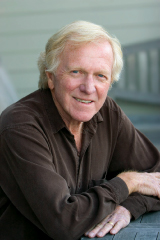here’s some good news regarding California politics. When was the last time you heard that? The following changes, currently being implemented, will result in state government being less partisan and once again working. Last June, voters passed Proposition 14, the Top Two Primaries Act. This means that in primary elections, everyone votes for everyone—and the top two vote-getters, regardless of party affiliation, will appear on the November ballot. The upshot, I predict, is that future candidates will have to appeal to the moderate middle, not the fringe.
Locally here’s how it will work: if, as many assume, Congresswoman Lynn Woolsey (D-Petaluma) retires, the race for her seat will be wide open. Potential June primary contenders include two-term Marin Assemblyman Jared Huffman, West Marin author-activist Norman Solomon, newly elected State Senator Noreen Evans (D-Santa Rosa) and popular Petaluma Mayor Pam Torliatt. All are Democrats.
Together, Marin and Sonoma counties have nearly 400,000 registered voters: 53 percent of them Democrats; 21 percent Republicans; 20 percent decline to state or are independent (unaffiliated); and 6 percent Green, American Independent, etc. Therefore, it’s a safe bet that Democrats will be the top two vote-getters in the June primary and advance to the general election. Here’s how I see that playing out: the strong liberal vote will go to Solomon, who has already pledged to “continue the legacy of Lynn Woolsey.” As for the rest of the Democrats? They will have to attract Republican and independent voters in order to appear on the final ballot.
Therefore, come November, we’ll have a purist versus a centrist—or an extremist against a moderate. Now that is a race! No longer will ultraliberals dominate Marin and Sonoma politics; likewise, no longer will archconservatives always win in Orange County. The top two primary rule applies to not only congressional races but also the California Assembly and Senate. This means a completely new (and energetic) political ball game, both in elections and in how government functions.
“After a few elections, we’ll get rid of the ideologues who’ve caused the gridlock,” says former Marin Assemblyman and longtime California political participant Bill Bagley. “And government will work once again.”
A second governmental improvement—again, already under way—involves California’s redistricting process. This is a result of Prop. 11 passing in 2008 and Prop. 20 in 2010. Here’s the short version: every 10 years or so, California’s Legislature determines boundaries for congressional, state Senate and Assembly districts. As politicians tend to do, they arrange these boundaries to most ensure their reelection. This process, devised by a governor of Massachusetts named Elbridge Gerry, is called gerrymandering, and it has resulted in political districts making little or no sense. Example: Marin State Senator Mark Leno’s 3rd District includes parts of Sonoma County, all of Marin—and neighborhoods in San Francisco including the Mission and Bayview–Hunters Point.
Now, thanks to Props. 11 and 20, a citizens’ commission, not politicians, will be establishing district boundaries and, instead of doing what is political expedient, will do it in a manner that creates a “community of interest.” This means, says former Sausalito Councilman Peter Van Meter, “a contiguous population sharing social, geographical and economic interests within a single district for purposes of fair and effective political representation.”
And Van Meter knows; he was one of 35,000 Californians who applied to be on the Citizens Redistricting Commission (CRC). “It was an exhaustive and complex process, like selecting a jury,” he recalls. “I made it to the final 340 applicants; from there, a nonpartisan panel interviewed 120 citizens, then 60, then 36, winding up finally with a 14-member commission.” As intended, five of the 14 members are Democrats, five are Republicans and four have vowed they are neither. Included on the CRC are a Yolo County bookseller, a Culver City urban planner and a legal scholar from San Francisco. There are eight men and six women from various ethnic and economic backgrounds. Information regarding the Citizens Redistricting Commission is available at wedrawthelines.ca.gov.
“Ultimately, this will result in much more responsive government,” says Van Meter. “It will be more middle-of-the-road and less partisan.” I agree. Now if we can get term limits extended to 12 years and alter the commercial real estate aspects of Prop. 13, California government will be back in business. That’s my point of view. What’s yours?
E-mail [email protected].


